

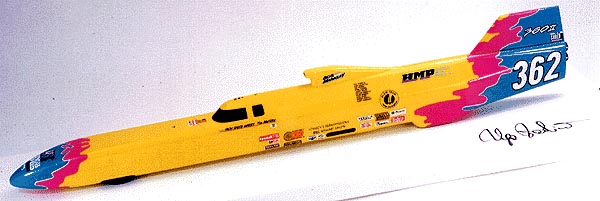
Go to the Hoffman-Markley streamliner model page |
|---|
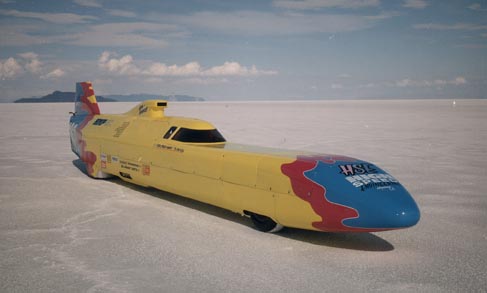
The Hoffman-Markley streamliner first appeared at Bonneville in 1990 and has been campaigned by the long-standing partnership of the Hoffmans (Harry Sr. and Harry Jr., the driver) and the Markleys (twin brothers Charlie and Bob "Bones", and later young Tim as second driver) for eight years, a relatively short period of time in Bonneville terms (many cars have run at the Salt Flats for decades), but long enough to allow the car to set the top record (the one for blown engines using unrestricted fuel) in three different BNI/USFRA classes, plus the FIA International record for Category A, Group I, Class 9 (up to 5 litres), three of which still stand today (summer 2000), while the C class record was taken, if only by a fraction, by Al Teague in 1998 - see Ugo Fadini model n.12.
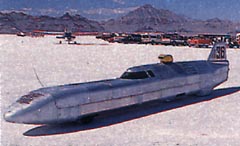
Built at the Hoffman's High Speed Engineering shop (while the Markleys were responsible for the engines) the car follows the old Bonneville rule of "the less parts, the less things that can break": there are no electronics and just four cables in all. The chassis is a cro-moly spaceframe, while the body is made of sheet aluminum. The engine is in central position, behind the driver. Traction is on the rear wheels only, via a truck transmision and a Halibrand box.
The aerodynamics are also pretty simple and, like on many Bonneville streamliners today, follow a design standard set by Mickey Thompson back in the sixties with his Autolite twin-Ford engined project.
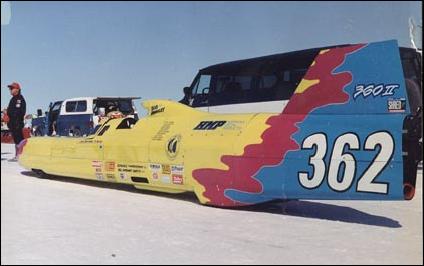
After the first year, when it appeared in unpainted form and still incomplete streamlining, the car later remained basically unchanged, except for engine swaps, until side "wings", in front of the rear wheels, were experimented in 1997, without much success.
The first engine used in 1990 at World of Speed and at the World Finals was an old 258 cu.in. De Soto, in true Hoffman & Markley tradition. The car topped a speed well over the existing record, but was unable to make a return run. In 1992, using a 300 cu.in. engine, at 358 mph the car took the oldest record still standing at the time, the Class D one, set in 1963 by the Summers Brothers, and later went on to set the FIA Class 9 International record at 357,472 mph.
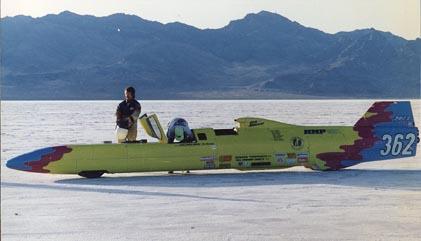
In 1993 and 1994 the Hoffman-Markley streamliner set fastest speed at World of Speed, but only in 1995 did it set a new record, this time in class E with the smaller engine, at 348 mph. In 1996 came its final record, in class C, with an engine just over the lower class limit and a speed of 365 mph, and increase of 36 MPH over the existing record.
After toying for a while with the idea of trying to be the first to do over 400 mph in a C class car, the Hoffmans finally decided to retire it from racing after the 1997 season, mainly due to the increasing difficulty to run safely with the available tyres on a most deteriorated surface, as the Bonneville Salt Flats were at the end of the '90s.
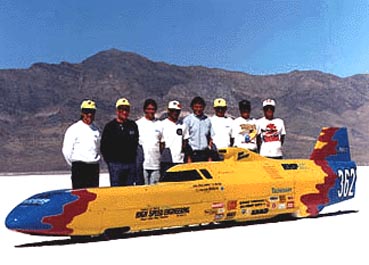
| venue | year | sanctioning body | class | distance | speed (mph) | standing |
|---|---|---|---|---|---|---|
| Bonneville World of Speed | 1996 | USFRA* | C/BFS | fl. mile | 365.422 | no |
| Bonneville World of Speed | 1995 | USFRA* | E/BFS | fl. mile | 348.150 | YES |
| Bonneville World of Speed | 1992 | FIA | A, I, 9 | fl. mile | 357.472 | YES |
| Bonneville World of Speed | 1992 | USFRA* | D/BFS | fl. mile | 358.536 | YES |

Go to the Hoffman-Markley streamliner model page |
|---|
For further information visit the |
|---|
Back to land speed record topics index. |
|---|
____________________________________________________________________________________________________________
Home | About Ugo Fadini | Current models | How to order | Discontinued models | Models to come | Articles & Stories | Links
© Ugo Fadini 2000/2014 - page last updated 5 August 2014